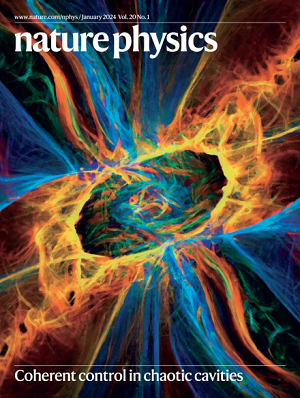铜超导体自旋磁化率的两个间隙特征
IF 18.4
1区 物理与天体物理
Q1 PHYSICS, MULTIDISCIPLINARY
引用次数: 0
摘要
理解高温超导铜酸盐的一个根本障碍是超导性的发生阻碍了低温下正常状态性质的观察。说明这个问题的一个重要性质是自旋磁化率:它在正常状态下冷却时的减少被认为是赝隙行为的证据。然而,对这种减少的明确解释是不可能的,因为关键的低温数据不可避免地反映了超导配对而不是正常状态。本文测量了YBa2Cu3Oy在低温下的自旋磁化率,同时抑制了高磁场下的超导性。我们发现有两种热激活的贡献,每一种都来自不同的间隙,以及由于无间隙激励而产生的残余成分。我们将这两个不同的间隙与短程电荷密度波和单重态的形成联系起来,就像在某些量子自旋系统中发生的那样。这两种现象都有助于低温下的赝隙,补充了在高温下引发赝隙行为的短暂反铁磁性。因此,我们提出赝隙应被视为一种复合性质,并且当不进行自旋条纹排序时,欠掺杂铜酸盐倾向于形成短程自旋单重态。本文章由计算机程序翻译,如有差异,请以英文原文为准。


Signatures of two gaps in the spin susceptibility of a cuprate superconductor
A fundamental obstacle to understanding high-temperature superconducting cuprates is that the occurrence of superconductivity hinders the observation of the normal-state properties at low temperature. One important property illustrating this issue is the spin susceptibility: its decrease upon cooling in the normal state is considered as evidence of pseudogap behaviour. However, unambiguous interpretation of this decrease has been impossible, as the crucial low-temperature data inevitably reflect the superconducting pairing rather than the normal state. Here we measure the spin susceptibility of YBa2Cu3Oy at low temperature while suppressing superconductivity in high magnetic field. We found that there are two thermally activated contributions, each of which comes from a different gap, alongside a residual component due to gapless excitations. We relate these two distinct gaps to short-range charge density waves and to the formation of singlets, as occurs in certain quantum spin systems. Both phenomena contribute to the pseudogap at low temperature, supplementing the short-lived antiferromagnetism that initiates pseudogap behaviour at high temperatures. We, therefore, propose that the pseudogap should be regarded as a composite property and that, when not undergoing spin-stripe ordering, underdoped cuprates tend to form short-range spin singlets. Measurements of the spin susceptibility in a model cuprate reveal the presence of two distinct gaps underlying the pseudogap behaviour. One gap is attributed to charge density waves and the other to the predicted formation of spin singlets.
求助全文
通过发布文献求助,成功后即可免费获取论文全文。
去求助
来源期刊

Nature Physics
物理-物理:综合
CiteScore
30.40
自引率
2.00%
发文量
349
审稿时长
4-8 weeks
期刊介绍:
Nature Physics is dedicated to publishing top-tier original research in physics with a fair and rigorous review process. It provides high visibility and access to a broad readership, maintaining high standards in copy editing and production, ensuring rapid publication, and maintaining independence from academic societies and other vested interests.
The journal presents two main research paper formats: Letters and Articles. Alongside primary research, Nature Physics serves as a central source for valuable information within the physics community through Review Articles, News & Views, Research Highlights covering crucial developments across the physics literature, Commentaries, Book Reviews, and Correspondence.
 求助内容:
求助内容: 应助结果提醒方式:
应助结果提醒方式:


